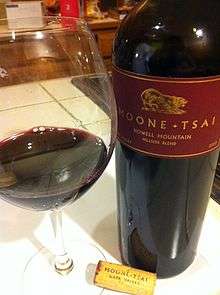American Viticultural Area

An American Viticultural Area (AVA) is a designated wine grape-growing region in the United States distinguishable by geographic features, with boundaries defined by the Alcohol and Tobacco Tax and Trade Bureau (TTB) of the United States Department of the Treasury.[1]
The TTB defines AVAs at the request of wineries and other petitioners. As of March 2015, there were 230 AVAs in the United States.[2] Prior to the AVA system, wine appellations of origin in the United States were designated based on state or county boundaries. All of these appellations were grandfathered into federal law and may appear on wine labels as designated places of origin, but these appellations are distinct from AVAs.
AVAs range in size from the Upper Mississippi Valley AVA at 29,900 square miles (77,000 km2) across four states (Illinois, Iowa, Minnesota, and Wisconsin),[3] to the Cole Ranch AVA in Mendocino County, California, at only 60 acres (24 ha).[4] The Augusta AVA surrounding the area around the town of Augusta, Missouri, was the first recognized AVA, gaining the status on June 20, 1980.[5]
Requirements
Current regulations impose the following additional requirements on an AVA:
- Evidence that the name of the proposed new AVA is locally or nationally known as referring to the area;
- Historical or current evidence that the boundaries are legitimate;
- Evidence that growing conditions such as climate, soil, elevation, and physical features are distinctive;
Petitioners are required to provide such information when applying for a new AVA, and are also required to use USGS maps to both describe (using terms from the map) and depict the boundaries.
Once an AVA is established, at least 85% of the grapes used to make a wine must be grown in the specified area if an AVA is referenced on its label.[6]
State or county boundaries—such as for Oregon or Sonoma County—are not AVAs, even though they are used to identify the source of a wine. AVAs are reserved for situations where a geographically defined area has been using the name and it has come to be identified with that area.
A vineyard may be in more than one AVA. For example, the Santa Clara Valley AVA and Livermore Valley AVAs are located within the territory of the San Francisco Bay AVA, which is itself located within the Central Coast AVA.
Current American Viticultural Areas
See also
- Appellation d'Origine Contrôlée
- Denominazione di origine controllata
- Indicazione Geografica Tipica
- American wine
References
- ↑ "Appellations of Origin", Alcohol and Tobacco Tax and Trade Bureau
- ↑ "List of established U.S. Viticultural Areas (last updated March 24, 2015)" (PDF). Alcohol and Tobacco Tax and Trade Bureau. U.S. Treasury. Retrieved 27 March 2015.
- ↑ "Upper Mississippi River Valley (AVA)". www.appellationamerica.com. Retrieved 2015-07-17.
- ↑ "Cole Ranch (AVA)". www.appelationamerica.com. Retrieved 2015-07-17.
- ↑ Code of Federal Regulations "Title 27, Volume 1", Alcohol, Tobacco Products and Firearms.
- ↑ "Requirement", Alcohol and Tobacco Tax and Trade Bureau
External links
- Appellations of Origin from the TTB website
- AVAs with links to detailed descriptions, from the Code of Federal Regulations located at a Cornell website
- Interactive Google AVA map from American Winery Guide